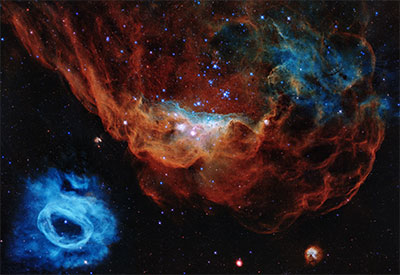Hubble Marks 30 Years in Space with Tapestry of Blazing StarbirthNASA is celebrating the Hubble Space Telescope's 30 years of unlocking the beauty and mystery of space by unveiling a stunning new portrait of a firestorm of starbirth in a neighboring galaxy.

In this Hubble portrait, the giant red nebula (NGC 2014) and its smaller blue neighbor (NGC 2020) are part of a vast star-forming region in the Large Magellanic Cloud, a satellite galaxy of the Milky Way, located 163,000 light-years away. The image is nicknamed the "Cosmic Reef," because it resembles an undersea world.
Thirty years ago, on April 24, 1990, Hubble was carried aloft from the Kennedy Space Center aboard the space shuttle Discovery, along with a five-astronaut crew. Deployed into low-Earth orbit a day later, the telescope opened a new eye onto the cosmos that has been transformative for our civilization.
Hubble is revolutionizing modern astronomy, not only for scientists, but also by taking the public on a wondrous journey of exploration and discovery. Hubble's never-ending, breathtaking celestial snapshots provide a visual shorthand for Hubble's top scientific achievements. Unlike any space telescope before it, Hubble made astronomy relevant, engaging, and accessible for people of all ages. The space telescope's iconic imagery has redefined our view of the universe and our place in time and space.
"Hubble has given us stunning insights about the universe, from nearby planets to the farthest galaxies we have seen so far," said Thomas Zurbuchen, associate administrator for science at NASA Headquarters in Washington, D.C. "It was revolutionary to launch such a large telescope 30 years ago, and this astronomy powerhouse is still delivering revolutionary science today. Its spectacular images have captured the imagination for decades, and will continue to inspire humanity for years to come."
Unencumbered by Earth's blurring atmosphere, the space observatory unveils the universe in unprecedented crystal-clear sharpness across a broad range of wavelengths, from ultraviolet to near-infrared light.
Hubble's top accomplishments include measuring the expansion and acceleration rate of the universe; finding that black holes are common among galaxies; characterizing the atmospheres of planets around other stars; monitoring weather changes on planets across our solar system; and looking back in time across 97% of the universe to chronicle the birth and evolution of stars and galaxies.
Hubble has yielded to date 1.4 million observations and provided data that astronomers around the world have used to write more than 17,000 peer-reviewed scientific publications, making it the most prolific space observatory in history. Its archival data alone will fuel future astronomy research for generations to come.
Hubble's longevity can be attributed to five space shuttle servicing missions, from 1993 to 2009, in which astronauts upgraded the telescope with advanced instruments, new electronics, and on-orbit repairs. The venerable observatory, with its suite of cameras and other instruments, is expected to stay operational through the 2020s, in synergy with the upcoming James Webb Space Telescope.
Cosmic Reef
The new space portrait is one of the most photogenic examples of the many turbulent stellar nurseries Hubble has observed during its 30-year lifetime. These regions are dominated by the glow of stars at least 10 times more massive than our Sun. The stellar inhabitants have short lives of only a few million years, compared to the 10-billion-year lifetime of our Sun.
The sparkling centerpiece of NGC 2014 is a grouping of bright, hefty stars, each 10 to 20 times more massive than our Sun. The stars' ultraviolet radiation heats the surrounding dense gas. The massive stars also unleash fierce winds of charged particles that blast away lower-density gas, forming the bubble-like structures seen on the right. The stars' powerful stellar winds are pushing gas and dust to the denser left side of the nebula, where it is piling up, creating a series of dark ridges bathed in starlight.
The blue areas in NGC 2014 reveal the glow of oxygen, heated to nearly 20,000 degrees Fahrenheit (11,000 degrees Celsius) by the blast of ultraviolet light. The cooler, red gas indicates the presence of hydrogen and nitrogen.
By contrast, the seemingly isolated blue nebula at lower left (NGC 2020) has been created by a solitary mammoth star 200,000 times brighter than our Sun. The blue gas was ejected by the star through a series of eruptive events during which it lost part of its outer envelope of material.












